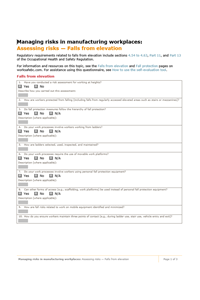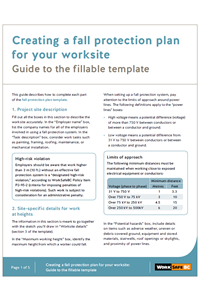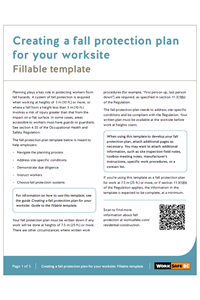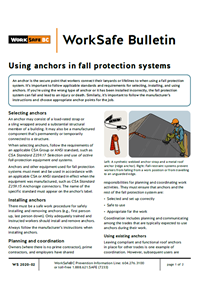Falls from elevation
Falls from elevation result in some of the most serious work-related injuries. Proper planning, supervision, training, and use of fall protection can reduce or eliminate the risk of falling from ladders, structures, buildings, roofs, vehicles, and scaffolds.
- The risks
- How to reduce the risks
- Resources
The risks
Nearly every worksite has the potential for a fall, whether it's from a short ladder, medium-sized truck, or a tall scaffold. A fall is usually the result of a combination of hazards, such as:
- Working at heights without proper fall protection
- Not following safe work procedures
- Slippery or uneven surfaces
- Overexertion
How to reduce the risks
The most effective way to reduce the risk of a fall is to eliminate the need to work at elevation. If that's not possible, there are four main ways to reduce risk, known as controls. These will be unique to each worksite and work environment. They include:
-
1
Guardrails
Where fall hazards cannot be eliminated, permanent or temporary guardrails or handrails form a protective barrier around an opening or edge to prevent a fall to a lower level.
-
2
Fall restraint
After eliminating fall hazards and installing guardrails, a fall restraint system is the next level in the fall protection hierarchy.
Fall restraint systems prevent you from falling through either travel restriction or work positioning. With travel restriction, workers are attached to a fixed-length line that prevents them from travelling to close to an opening or edge.
-
3
Fall arrest
When it's not possible or practical to use a fall restraint system, the next line of protection is fall arrest.
A fall arrest system (including a lanyard or lifeline, a harness, and, most importantly, an anchor) protects you after a fall by stopping you from hitting the surface below
-
4
Work procedures
An example of a safe work procedure is using three points of contact when climbing onto or down from equipment. Either have two feet and one hand or two hands and one foot on the equipment at all times. Use the parts designed by the manufacturer for climbing, such as steps, rungs, running boards, footholds, and handgrips. Do not use parts that can move or shift when you are climbing.
In construction, if guardrails, fall restraint, or fall arrest are not practicable, or will result in greater risk of injury, contact the Prevention Information Line to discuss alternative safe work procedures that are acceptable to WorkSafeBC.
Highlights
- New resources help construction employers create fall protection plans specific to their worksites Published on: May 20, 2021
- New slide show re-enacts a carpenter’s fall from ladder, then through opening in floor Published on: October 30, 2019




